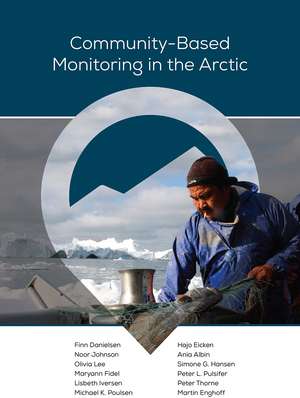Community-Based Monitoring in the Arctic
Autor Finn Danielsen, Noor Johnson, Olivia Lee, Maryann Fidel, Lisbeth Iversen, Michael K. Poulsen, Hajo Eicken, Ania Albin, Simone G. Hansen, Peter L. Pulsifer, Peter Thorne, Martin Enghoffen Limba Engleză Paperback – 15 feb 2021
Contributors include Finn Danielsen, Noor Johnson, Olivia Lee, Maryann Fidel, Lisbeth Iversen, Michael K. Poulsen, Hajo Eicken, Ania Albin, Simone G. Hansen, Peter L. Pulsifer, Peter Thorne, and Martin Enghoff.
Preț: 214.24 lei
Nou
Puncte Express: 321
Preț estimativ în valută:
41.00€ • 42.65$ • 33.85£
41.00€ • 42.65$ • 33.85£
Carte disponibilă
Livrare economică 24 martie-07 aprilie
Livrare express 08-14 martie pentru 23.06 lei
Preluare comenzi: 021 569.72.76
Specificații
ISBN-13: 9781602234284
ISBN-10: 1602234280
Pagini: 116
Ilustrații: 11 halftones, 11 tables
Dimensiuni: 178 x 254 x 13 mm
Greutate: 0.34 kg
Editura: University of Alaska Press
Colecția University of Alaska Press
ISBN-10: 1602234280
Pagini: 116
Ilustrații: 11 halftones, 11 tables
Dimensiuni: 178 x 254 x 13 mm
Greutate: 0.34 kg
Editura: University of Alaska Press
Colecția University of Alaska Press
Recenzii
The manuscript is the first to my knowledge that compiles so much information from so many CBM efforts in one place. (…) With this report in hand, proponents of CBM projects should be able to address most objections to their ideas, while also refining their approaches to reflect what has and hasn’t worked elsewhere. It is thus valuable for practitioners as well as scholars, and for those considering funding or partnering with CBM efforts, who will be able to better distinguish well-conceived efforts from half-baked proposals. (…) Its clear-headed advice and ideas should also appeal to those involved in CBM elsewhere in the world. (…) This makes a major contribution to turning CBM from a politically correct afterthought to “real” science, into a rigorous and respected practice in its own right. - Henry P. Huntington
The issues of better integrating CBM programs with government agency programs and ensuring that decision-making processes not only use those data but also respect the rights of resource-dependent communities to shape decision making are two key and timely themes that are placed front and center in this manuscript. This will make the publication a key contribution in CBM literature. - Kirsten M. Silvius
Notă biografică
Finn Danielsen is an ecologist. He is with the Nordic Foundation for Development and Ecology (NORDECO) in Copenhagen, Denmark.
Cuprins
Acknowledgments
Foreword
1 Introduction
1.1 Methods
2 Capabilities
2.1 Introduction
2.2 Characteristics of Arctic CBM Programs
2.3 Coverage of Arctic CBM Programs
2.4 The Framework and Format of Knowledge Products from the Arctic CBM Programs
2.5 Linkages to International Agreements and UN Sustainable Development Goals
2.6 Summary: Capabilities
3 Good Practice
3.1 Good Practice: Establishing CBM Programs
3.2 Good Practice: Implementing CBM Programs
3.3 Good Practice: Sustaining CBM Programs
3.4 Good Practice: Obtaining Impacts Through CBM
3.5 Good Practice: Connecting and Cross-Weaving with Other Approaches
3.6 Good Practice: Ensuring the Quality of Knowledge Products
3.7 Good Practice: Addressing the Rights of Indigenous and Local Communities
3.8 Summary: Good Practice
4 Challenges and How to Address Them
4.1 Challenge: Limited Ability or Interest of Management Agencies to Access,
Understand, and Act on CBM-Derived Guidance
4.2 Challenge: Insufficient Linkages Between CBM Programs and the Priorities of
Northern Communities
4.3 Challenge: Sustaining Community Members’ Long-Term Commitment to CBM Efforts
4.4 Challenge: Lack of Compatibility Between Data Formats of Scientist-Executed Monitoring and CBM Programs
4.5 Challenge: Intellectual Property Rights, Respect and Reciprocity, and Free, Prior, and Informed Consent (FPIC)
4.6 Challenge: Organizational and Support Structures for CBM Programs
4.7 Summary: Challenges and How to Address Them
5 Moving Forward with CBM in the Arctic
Appendix A. Arctic CBM Programs
Appendix B. CBM Practitioner Questionnaire
References
Index
Foreword
1 Introduction
1.1 Methods
2 Capabilities
2.1 Introduction
2.2 Characteristics of Arctic CBM Programs
2.3 Coverage of Arctic CBM Programs
2.4 The Framework and Format of Knowledge Products from the Arctic CBM Programs
2.5 Linkages to International Agreements and UN Sustainable Development Goals
2.6 Summary: Capabilities
3 Good Practice
3.1 Good Practice: Establishing CBM Programs
3.2 Good Practice: Implementing CBM Programs
3.3 Good Practice: Sustaining CBM Programs
3.4 Good Practice: Obtaining Impacts Through CBM
3.5 Good Practice: Connecting and Cross-Weaving with Other Approaches
3.6 Good Practice: Ensuring the Quality of Knowledge Products
3.7 Good Practice: Addressing the Rights of Indigenous and Local Communities
3.8 Summary: Good Practice
4 Challenges and How to Address Them
4.1 Challenge: Limited Ability or Interest of Management Agencies to Access,
Understand, and Act on CBM-Derived Guidance
4.2 Challenge: Insufficient Linkages Between CBM Programs and the Priorities of
Northern Communities
4.3 Challenge: Sustaining Community Members’ Long-Term Commitment to CBM Efforts
4.4 Challenge: Lack of Compatibility Between Data Formats of Scientist-Executed Monitoring and CBM Programs
4.5 Challenge: Intellectual Property Rights, Respect and Reciprocity, and Free, Prior, and Informed Consent (FPIC)
4.6 Challenge: Organizational and Support Structures for CBM Programs
4.7 Summary: Challenges and How to Address Them
5 Moving Forward with CBM in the Arctic
Appendix A. Arctic CBM Programs
Appendix B. CBM Practitioner Questionnaire
References
Index
